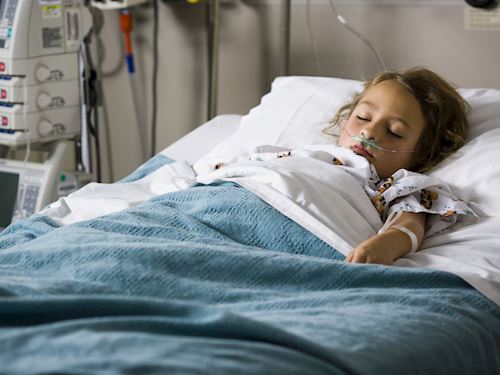 1. Acute lymphocytic leukemia is the most common type of leukemia found in children. ALL accounts for about two-thirds of all cases. In ALL there is a proliferation of lymphoblasts, causing a decrease in other cell types.
1. Acute lymphocytic leukemia is the most common type of leukemia found in children. ALL accounts for about two-thirds of all cases. In ALL there is a proliferation of lymphoblasts, causing a decrease in other cell types.
2. Noah's symptoms at the time of his return visit to his pediatrician were not alarming. He was very tired; his mother assumed this was due to a recent Strep infection. He did have some bleeding and bone pain. Symptoms in ALL come on abruptly and include fatigue (caused by anemia), bleeding (resulting from thrombocytopenia), and fever due to infection. Bone pain is often present due to the infiltration of leukemic cells. If the cerebral or spinal meninges have been infiltrated, the patient may exhibit neurological symptoms including a headache, vomiting, and blurred vision.
3. Acute leukemias are diagnosed on clinical and laboratory findings. Noah's pediatrician made the initial diagnoses based on the peripheral blood smear which showed the presence of blasts. The pathologist confirmed the diagnosis from a bone marrow examination which showed a hypercellular bone marrow with greater than 30% blasts. Cytochemical stains and immunologic marker studies are performed to differentiate the different leukemias.
4. Treatment consists of chemotherapy and supportive therapy such as blood transfusions and antibiotics. In ALL, intrathecal chemotherapy, spinal radiation, or a combination of both are usually needed. Bone marrow transplants are now being used successfully, usually in patients who have a recurrence of leukemia.
5. The five-year survival rate for children diagnosed with leukemia and subsequently treated is approximately 70%. The response to treatment varies greatly for each individual. Recovery rates are constantly improving with continuing research of new and better methods to treat leukemia.
6. Although the cause of leukemia is not known, certain risk factors have been identified which increase the chance of developing leukemia. Risk factors include exposure to high-energy radiation, electromagnetic fields, and certain chemicals such as benzene. Avoidance of these environmental risk factors may aid in prevention. Other risk factors may be genetic and/or viral in nature and at this point cannot be prevented.
7. Many health professionals work together to treat a child with leukemia. In this case, the pediatrician made the initial diagnosis and then referred the child to a pediatric oncologist who specializes in the treatment of childhood diseases of the blood. Nurses are the main link between the health care team and the family. They care for the child during hospital stays performing a multitude of duties including checking vital signs, starting I.V.'s, giving medications, and making sure the child is comfortable. The patient often receives chemotherapy in the oncologist's office. Nurses work with the oncologist to deliver chemotherapy and educate cancer patients about their disease. Medical laboratory technologists perform laboratory testing which aids in the diagnosis and continual assessment of the child's condition. The pathologist obtains and analyzes bone marrow samples. The secondary complication of pneumonia was treated by respiratory therapists who assessed breathing capacity and administered oxygen. The radiological technicians obtained chest x-rays, which allowed the radiologist to diagnose life-threatening pneumonia. All of the health care team worked together in diagnosing and treating this child.
